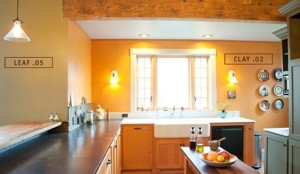current news

What Makes Up a True no VOC Paint?
February 28, 2013
VOC is short for volatile organic compound; chemical liquids that evaporate at room temperature. Some examples of solvents used in low VOC or traditional paints are propylene glycol and paint thinner/turpentine. Traditional resins/binders (the stuff that sticks t o the wall and binds the pigment) required chemical solvents to form a film as the paint dried.
o the wall and binds the pigment) required chemical solvents to form a film as the paint dried.
In general, when no VOC paint is discussed, only the base un-tinted product is being referenced. The other aspect making up paint is the pigments used to tint the paint. Each ounce of traditional colorants can add anywhere between 5 and 20 grams of VOCs per liter of paint. The amount of colorant in an off-white paint many not be significantly high, but a rich or dark-tinted color could mean adding 100 or more grams of VOCs per liter of paint.
One of the brands Originate represents is YOLO Colorhouse. YOLO’s only solvent in their paint is water. No VOC tints are available and set apart traditional low and zero VOC paints. The only tints Originate uses are No VOC tints, so you end up with a True No VOC Paint in any color.
If everyone in the US used zero VOC paint instead of a ‘low VOC’ or traditional paint, we would eliminate between 150 million to 1 billion pounds of chemical solvent from being released into the atmosphere. According to the US Environmental Protection Agency (EPA), VOC concentrations are consistently higher indoors (up to ten times higher). Paint is a significant contributor to indoor air quality because walls and ceilings are roughly 70% of your interiors surface.
